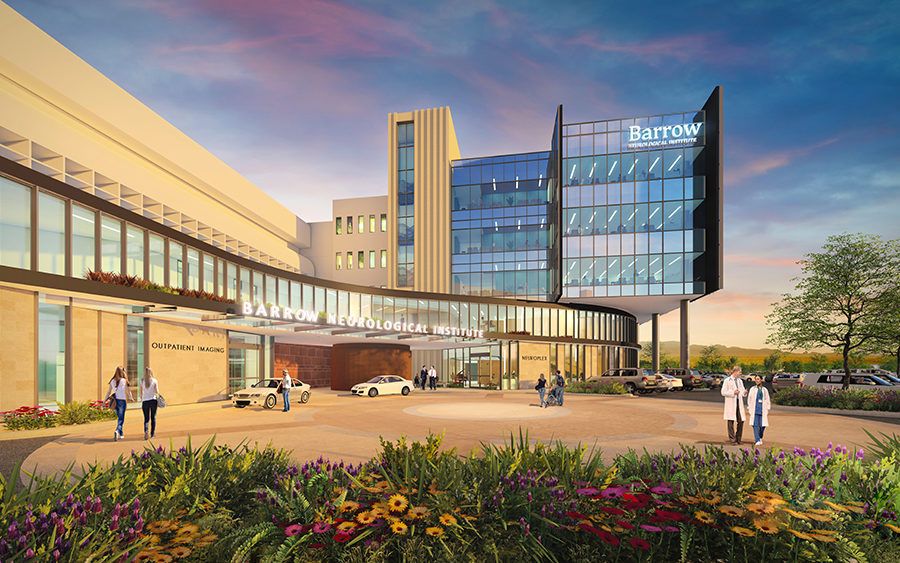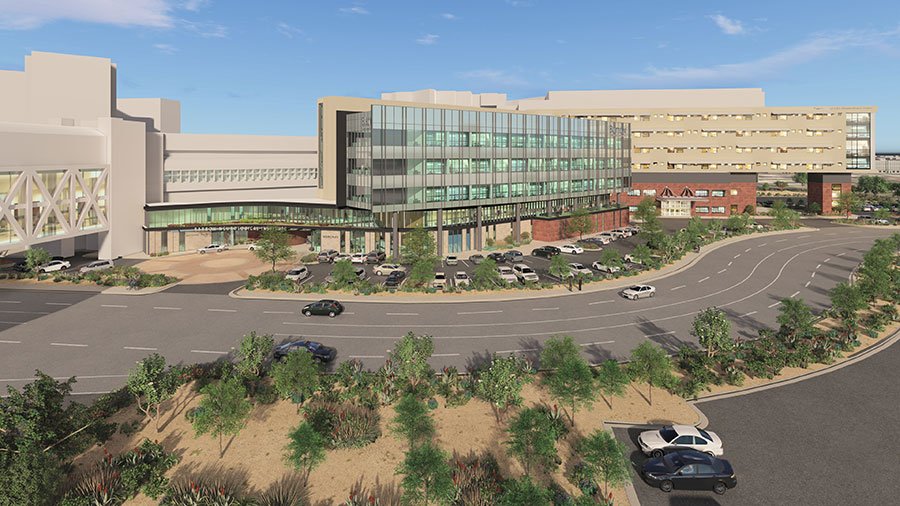
Neuroplex Q&A with Barrow COO Tom Bour
Where is construction at currently?
We built the building in two phases. The first phase was the shell and core building, which is basically everything except the actual build-out of the inside spaces, so this was the building structure, the outside glazing, all the mechanical systems, etc. That phase is done, and we’ve accepted the building from the general contractor, Kitchell.
The second phase is to build out the interior shelled spaces, called tenant improvements, and this work is underway right now. This work will finish up in three different phases, starting with the first- and fourth-floor Barrow Neurological Institute programs, followed by the Barrow Brain and Spine clinic on the second floor, and finally, on the first floor, the new ambulatory surgery center for the outpatient spine surgery.
What are the anticipated completion dates?
We’re forecasting that the tenant improvements will be done this October, but we’ll still have to go through the State licensure inspection before those suites can open.
Barrow Brain and Spine will probably be done in January of 2022. They will not have to go through a licensure inspection, so they will be open right then.
The ambulatory surgery center will probably be done in summer of 2022.
When will we begin seeing patients in the Neuroplex?
Somewhere between October and December, depending on when the Department of Health Services issues licenses.
Will there be a grand opening ceremony for employees?
There will be, when temperatures are below triple digits and when the tenant improvements are done. So it will probably be in the fall.
Can you elaborate on the layout of the Neuroplex?
It’s a five-story building. The fifth floor and half of the third floor are shelled for future growth.
The first floor is going to feature the pre-operative center and the ambulatory surgery center. The pre-operative center will be moving out of the second floor of the hospital and into an actual clinic on the first floor of the Neuroplex. So anybody coming in for surgery will go through the center, and that will be a much friendlier experience.
The second floor is 100 percent Barrow Brain and Spine. That’s where their clinic will be. The half of the third floor that’s not shelled will be for their physician offices and their back-office personnel.
The fourth floor will have Barrow Neurological Institute departments. We’ll move neuro-endocrinology and Barrow Neurological Foundation there from the 124 Building, and the neuro-infusion suite, stroke clinic, and neuro-oncology clinic there from the 240 Building. So it will be a very busy fourth floor.
What will happen with those vacated spaces?
Once everybody is moved out, we will go back and do some renovations on the fourth floor of the 240 Building. We’re going to keep a research infusion suite on the fourth floor, where it is today, but it’s going to get smaller. The portion that we renovate will be turned over to the Department of Neurology for expanding their clinic footprint.
Then, we’ll do a major renovation of the Barrow Brain and Spine suite by the Marley Lobby, which is a 25,000-square-foot area. We’ll move Barrow Academic Affairs and Neuroscience Publications to that area, and then the remaining part of the suite will be for neuro-engineering and research laboratories.
Can you talk more about how the Neuroplex will benefit both patients and staff?
The purpose of the building is to improve our competitiveness for ambulatory space. The St. Joseph’s Hospital campus in general doesn’t have enough outpatient space; it’s heavily skewed toward hospital space. Barrow has enough inpatient beds, 220 total, so we’ve been working steadily at getting all of our ambulatory clinics to a large enough footprint to accommodate the anticipated growth in outpatient health care.
The 240 Building needs to be resized to accommodate our neurology clinic throughput. We have also needed to strengthen our neurosurgery clinic footprint for some time. The neurosurgeons’ current clinic space is dated and would have been expensive to renovate. Moving the Department of Neurosurgery into the Neuroplex solves this problem. Our infusion program is growing rapidly due to insurers pushing patients into freestanding infusion centers, so we had to grow this program and set –up an adjoining infusion pharmacy.
Lastly, we badly needed an ambulatory surgery center for spine surgery. Spine surgery is moving out of the hospital quickly, and we would rather keep it right here on campus, where our neurosurgeons will be able to just go downstairs from their office and do their ambulatory surgeries, or go out the back door and do their inpatient surgeries, since their new suite connects into the hospital OR.
For our patients, the nice part is they won’t have to wander all over this 2 million-square-foot campus or make the hazardous trek across Third Avenue. They can just pull into the parking lot in front of the Neuroplex, walk 10 steps into the building, and go up the elevators to see their neurosurgeon or neurologist.
By putting that building where it is, it connects to the hospital at the Third Avenue Bridge, the second floor surgical suite, and at the first floor, between EEG and outpatient imaging. For outpatient services, convenience and accessibility are key. Our ultimate goal is the fewest number of steps for our patients and staff, and I think this building accomplishes that.
How long has the Neuroplex been in the works?
We started on the building project six years ago. We always try to plan ahead five to 10 years. If we aren’t always looking ahead, we’re going to fall behind the market. We developed this project knowing that changes in health care delivery will be coming. We think this building will meet our outpatient needs through the next 10 years. We still have shelled space to deal with ambulatory and inpatient growth, and then we’ll be ready for another building.
Can you elaborate on the changes in health care you mentioned?
A few things are happening. Surgery in general is becoming more minimally invasive, with less time spent in the hospital. This is happening across the board, and neurosurgery is no different. Insurers are pushing all the time to move care out of the hospital setting to reduce costs. Lastly, the city of Phoenix—and Arizona in general—is growing. We’re having population growth that’s leading to more demand for health services.
So it’s a balancing act between some procedures moving out of the hospital and creating room for the acute-care patient volume that is driven by population growth. This is good for patients and hospitals. It’s a sign of medical progress that more types of medical care can be safely delivered in an outpatient setting.
How was the Neuroplex funded?
The Neuroplex was funded as a partnership between the Dignity Health system and Barrow Neurological Foundation. With Dr. Robert Spetzler’s retirement, we raised about $11.5 million for a new building. The Dignity Health system contributed the remainder of the cost, which was over $30 million. We are appreciative of their support.
Is there anything else you would like the Barrow team to know about the Neuroplex?
My major message to the Barrow team is that our philanthropy comes from grateful patients. The fact that we have so many grateful patients who are willing to re-invest in us is a testament to the quality of the work from everybody who takes care of them. It’s a testament that we’re making a difference at a really difficult time in their lives, and they remember us. From the moment a person sets foot on this campus, they notice a difference with Barrow. And when they have the means to do so, they want to give to support our programs.
So I just want to tell everybody on the Barrow team: Keep doing what you’re doing. It’s definitely noticed. Most importantly, it’s noticed by our patients.
What other construction projects should employees be aware of?
Stay tuned for another Barrow building coming later this year. We’ll be starting on that this summer, so we are going to continue to be really busy through the end of 2022 with our building projects.
The other thing I want to mention is that the Third Avenue Bridge is being renovated slowly and at times painfully, but it will get done. This path of travel is really important for our patients and staff. The new stairway off the Third Avenue Bridge that we just finished will also benefit our rehabilitation patients, who will use the new overhead harness system for ambulation assistance.
We’re also working on the Resilience Park outside of the Muhammad Ali Parkinson Center, which will give patients and families a place to go outside and decompress from the neurology clinic and inpatient rehabilitation unit.
All of these projects will tie together, and more is coming. And that’s the way it should be at Barrow.
This interview has been edited for brevity, clarity, and flow.

